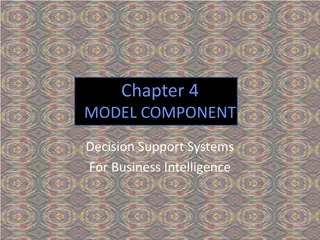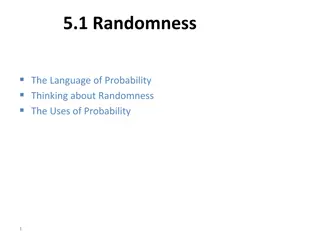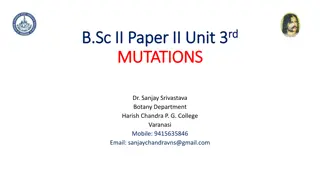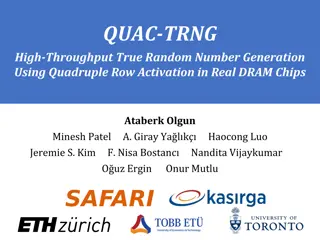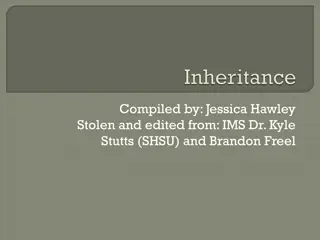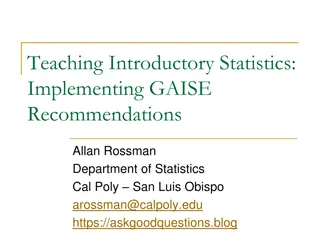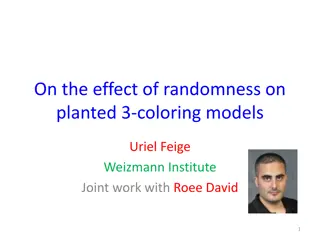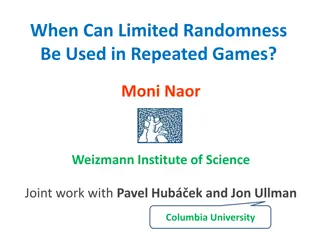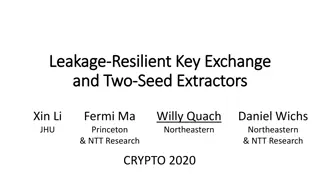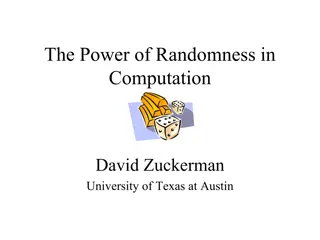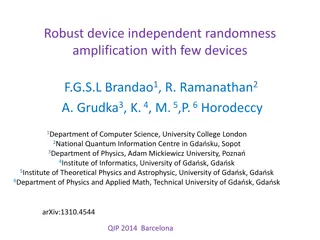
Probabilistic Complexity Classes in Computer Science
Explore the concepts of randomness, metrics, and complexity in computer science through a series of informative slides covering topics such as pseudorandom number generators, cryptography, Monte Carlo simulations, and more.
Download Presentation

Please find below an Image/Link to download the presentation.
The content on the website is provided AS IS for your information and personal use only. It may not be sold, licensed, or shared on other websites without obtaining consent from the author. If you encounter any issues during the download, it is possible that the publisher has removed the file from their server.
You are allowed to download the files provided on this website for personal or commercial use, subject to the condition that they are used lawfully. All files are the property of their respective owners.
The content on the website is provided AS IS for your information and personal use only. It may not be sold, licensed, or shared on other websites without obtaining consent from the author.
E N D
Presentation Transcript
Randomness Slides by Dan Fu
Outline Randomness & Metrics Random complexity classes Randomized algorithms Pseudorandom number generators (PRNG) PRNG disasters
What needs randomness? Cryptography & Encryption keys Monte Carlo simulations Random trials Statistical sampling Shuffling music (not actually random) Computer games Complexity classes! Randomized algorithms!
Why complexity? Class of problems that can be solved on a probabilistic polynomial time Turing Machine. Captures efficiently computable better than P. Probabilistic complexity classes allow us to reason about the difficulty of certain results: Approximation algorithms for some optimization problems in NP-Complete have bounded ratios (PCP Theorem) Interactive proof systems and zero-knowledge proofs are important for cryptography and understanding how to only transmit necessary information
Probabilistic Turing Machine How can a probabilistic Turing machine be defined by a deterministic TM?
How to measure randomness? Kolmogorov complexity The program to generate the random string cannot be shorter than the string itself Shannon entropy A measurement of the unpredictability of a random variable. ? ? = ?=1 ? ?? log?? ?? ? ? = 1 is perfect randomness Statistical measures Uniform frequency of numbers, taken 1, 2, digits at a time Graphical Plot the values generated in 3D then rotate to look for patterns ?
Probabilistic Complexity Classes Class RP [Arora] If a problem in this class is run numerous times, the chance it is incorrect becomes very low. Monte Carlo algorithms What complexity class represents Las Vegas algorithms (never wrong?) Source: Wikipedia (Means the IF it returns a result, it will be correct, but it may not always return a result.)
Probabilistic Complexity Classes Class ZPP ZPP ZPP = RP Why is this never wrong? Run both TMs in turn Look at each combination of Accept/Reject for the machines. What do each of those imply for the result of the ZPP? RP coRP coRP
Randomized Algorithms Quicksort (Las Vegas algorithm) Randomly choosing a pivot. On average, expect to choose a good pivot. O(n log n) Estimating ? Random variables X and Y into the equation ?2+ ?2 Then average points 1, multiply by 4, how many points are in the circle? We now take for granted the random number generators we use to generate the RVs
Random number generators Can t really use dice, coin flips, or cracks in turtle shells and animal bones baked over an open fire for a computer A computer is deterministic, there is no intrinsic randomness Ferranti Mark 1 implemented random bits using electrical noise (hardware source) Great! But not really. Programmers wanted to test random inputs predictably. Instead use a pseudorandom number generator Algorithm that generates a very long, seemingly unrelatedsequence of numbers based on a seed (which has a random source) From University of Manchester CS
Pseudorandom Number Generators PRNGs are periodic algorithms (but that period is very large) A seed controls which path through the period the numbers take PRNGs must generate a sequence of numbers that Have no correlation to past values Should not repeat within the practical lifespan of its application Has no bias for a specific range or frequency of values Should be as close to true random as possible
True random vs Pseudorandom True random is entirely unpredictable. It has no algorithmic basis. Can be hard or unnecessary to implement True pseudorandom uses a hardware seed (e.g. Random.org uses atmospheric pressure) fed into a pseudorandom algorithm But slight problem if these values don t change fast enough or with enough measurable significance Or change when you don t want them to Take for instance our Monte Carlo example, what happens if that process is not random enough?
Early PRNGs John von Neuman (1946): Starting with a seed, square it, then remove the middle digits, then repeat Very periodic. D. H. Lehmer (1949) Seeded with the time Generated a number between [0, 1] ? = 9301? + 49297 mod 233280 233280 This was coined the Linear Congruential Generator (LCG) , which is a prototypical form of a PRNG What s the period?
Modern PRNGs LCGs are still in use today! Java s RNG is an LCG Mersenne Twister Period is a Mersenne prime, a prime number that is 1 less than a power of 2 219937 1 It s fast! Especially when compared to waiting for changes in hardware sources. Good enough for most things! Still guessable after observing only a few hundred iterations. LCGs are not good enough for cryptography Most can be cracked with statistical tests
Cryptography PRNGs Pass any polynomial-time statistical test with some assumptions Blum Blum Shub (BBS) Nonlinear PRNG ??+1= ?? Very slow ? = ??, where ? and ? are large primes, assuming factorization is hard. Linear-feedback shift registers Used to encode stream ciphers XOR the last state 2 mod ?
Cryptography How does randomness affect security?
PRNG Disasters: RANDU ??+1= 65539 ?? mod 231, ?0 is odd. It was easy to do on 32 bit hardware Values generated by RANDU end up repeating. A lot of simulation results from the 1960s are in doubt because of this. See: Wikipedia s page on RANDU
PRNG Disasters: Using Time PRNG demand exploded in the 1990s with the internet Netscape (old browser) SSL communications were based on a PRNG that used time and a selection of process IDs as a seed. Reverse engineered in 1994, but Netscape resisted calls to confirm because it thought allowing people to access its source would be less secure Hacker News (website) login cookies were randomly assigned IDs seeded at server start time By crashing the server, logging the server start time, then checking their personally assigned ID, hackers could line up their ID with potential seeds. Then they could change cookies to trick the server into logging them in with someone else s account.
PRNG Disasters: Debian SSL Library 2008 Poor coding and communication An uninitialized variable was originally included in the PRNG seed (together with PIDs, time, UIDs) to add a random memory location A memory debugger later applied detected this as a memory error A developer unwittingly removed this line, reducing the period of the PRNG to a mere 32,768 (matching the max number of available PIDs) And this is was not reverted for another 2 years
PRNG Disasters: Lottery 2010 A developer added code to fix their PRNG seed for a draw on a specific date and time Almost got away with winning $16 million if not for the non- anonymity lottery rules
Summary The complexity of randomness and how we can exploit it is an important area of study with many applications In choosing RNGs, it is important to pick the right one for the application. LCGs fulfill most purposes, but consider: Its resource use, i.e. the processing power and memory requirements to calculate it Accessibility of its seed source Does it need to be truly random?


